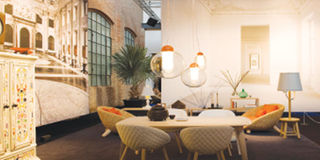Put a pretty face on it!

Marcel Wanders’s Love chairs and sofas and Scholten & Baijings’s Colour Globe lights at Moooi’s “Unexpected Welcome” show in Milan.
What you need to know:
- Taking a cue from fashion, design companies introduce fresh collections every year in Milan. However, because of the durable nature of their goods and the expense of creating new ones, it is impossible to make grand gestures year after year.
- And most important, it is super cute, a verdict that Lehanneur accepted with grace. “My intention was to make an object like a piece of fruit,” he said. “As soon as you put it on a table, you want to pick it up and touch it.”
MILAN: At the 53rd International Furniture Fair here, which ended Sunday, the German designer, Konstantin Grcic, introduced a chair for the Finnish company, Artek.
Running into him midweek, I congratulated him on the piece. “You’ve gotten in touch with your inner girl,” I said. Grcic looked surprised. The chair, called Rival, was designed for the gender-neutral territory of the home office. It has neat proportions to fit into modestly sized spaces. And because it is a task chair, it swivels.
However, there is no denying that Rival is super cute. Its upholstered seat is shaped like a soup bowl, and its birch legs are planted like a cheerleader’s. One version was shown in bright vermilion.
Rival’s approachability had much to do with its homey Nordic heritage, which Grcic has brought up to date. It also fit into the landscape of this year’s fair, where objects were scaled down, warmed up, and made tactile and visually delightful, often through a creative use of fabrics. It was as if all of Milan had gone Scandinavian.
GRAND GESTURES
Taking a cue from fashion, design companies introduce fresh collections every year in Milan. However, because of the durable nature of their goods and the expense of creating new ones, it is impossible to make grand gestures year after year.
What the companies appear to have learned is that textiles can lend humanity and originality to products with relative ease.
“Design has woken up to colour and texture,” said Nipa Doshi, a London designer who is an expert at both. (She and her husband and partner, Jonathan Levien, were introducing sprightly, gestural carpets for Nanimarquina.)
Doshi added that she would be relieved to say goodbye to an era of shiny white plastic but warned that fabric brings its own challenges. It is “an area designers are not comfortable with,” she said. “Because textiles do what they want to do.”
Colour may be easier to manage, and one in particular took over Milan this year. Blushing sofas, cotton candy-hued lamps, and peony painted chairs bloomed around this saffron city. Were these the rosy shades of optimism? Probably not. The European furniture industry has been plagued by recession for so long that its leaders can no longer muster even the pretence of cheerfulness.
By peddling delicate colours, rich textures, and domestic comforts, design companies are demonstrating a realistic understanding of what is marketable. “Sometimes design is too polite,” Erwan Bouroullec, said, adding: “The brutality comes from the process: You hammer like hell the iron. Poor iron!”
One of the simplest-looking objects at the fair may have been the stealthiest: Boom Boom, a Bluetooth-enabled speaker in a white faceted ball developed by Mathieu Lehanneur of Paris for Binauric, a young audio company. Capable of much more than diffusing sound, the device is an open platform loaded with technology that will allow it to record sound, perform as a musical instrument or game, or undertake any number of other functions, all without requiring additional components.
And most important, it is super cute, a verdict that Lehanneur accepted with grace. “My intention was to make an object like a piece of fruit,” he said. “As soon as you put it on a table, you want to pick it up and touch it.”




